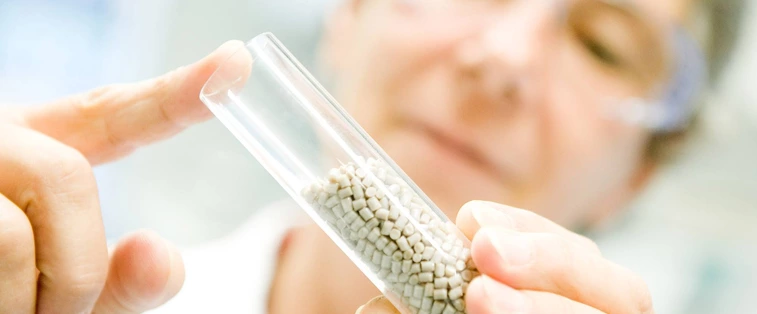

2020-10-20
Evonik launches next-generation PEEK biomaterial for medical technology applications
Evonik has developed a new osteoconductive polyether ether ketone (PEEK) for the medical technology market that improves the fusion between the bone and the implant.
IMPROVING QUALITY OF LIFE BY HELPING BONES HEAL FASTER
The osteoconductive properties of the new PEEK material were achieved by using a special functional additive - biphasic calcium phosphate - and allow bone cells to adhere to implants more quickly, thus positively influencing fusion, so called osteointegration, at the boundary between the bone and the implant. This, in turn, will accelerate bone fusion and convalescence.
As the first biomaterial in Evonik’s new Fusion product line, VESTAKEEP® iC4800 will impress customers with its outstanding mechanical properties, which are similar to those of human bone. Like all other PEEK-based, high-performance polymers for medical technology applications, the newly developed biomaterial does not produce any artifacts in imaging processes such as X-ray or MRI. However, the additives provide a natural desired shadow for accurate placement and observation of the fusion process.
DEVELOPMENT OF CUSTOMER-SPECIFIC BIOMATERIALS
“Introduction of the new VESTAKEEP® Fusion product line represents an important step in the strategic development of our portfolio. This work draws upon our decades of expertise in polymer chemistry and on Evonik’s global innovation and production network. That foundation means we can offer patients a one-of-a-kind product and significantly improve their quality of life,” says Marc Knebel, Head of the Medical Systems market segment at Evonik.
In addition to VESTAKEEP® iC4800, Evonik will offer to its customers within the new PEEK Fusion product line the development of further exclusive, customer-specific materials with bioactive properties as so-called VESTAKEEP® Fusion Select products. They are developed from a library of established osteoconductive substances with close involvement with each customer.
EXCELLENT PROCESSING CHARACTERISTICS IN INJECTION MOLDING
Consciously developed for processing using a variety of production technologies, VESTAKEEP® Fusion will come both as a granulate and as a semifinished stock-shape product. Like all previous PEEK products, it can be milled, compression molded, and extruded as usual.
Evonik’s new osteoconductive PEEK biomaterial can also be injection molded in the proven manner. It has been specially designed so that the functional additives are available on the surface and no film formation occurs. In collaboration with Samaplast, a Swiss company specializing in plastics engineering, Evonik has successfully demonstrated and documented the processing characteristics of VESTAKEEP® Fusion in injection molding.
Evonik’s polymer experts are also studying the possibility of developing a 3D printable filament with VESTAKEEP® Fusion for next-generation PEEK that could be processed using the fused filament fabrication (FFF) additive production technology.
METAL-FREE ALTERNATIVE TO TITANIUM, STAINLESS STEEL OR COBALT-CHROME IMPLANTS
The new product line and its osteoconductive properties expand Evonik’s existing portfolio of biomaterials for implants in long-term contact with the body, offering a metal-free alternative to titanium implants.
Evonik has been the world’s leading manufacturer of high-performance polymers for medical technology applications for over 20 years. The specialty chemicals company offers an extensive portfolio of biomaterials suitable for use in manufacturing medical devices intended for both temporary and long-term contact with the body.
